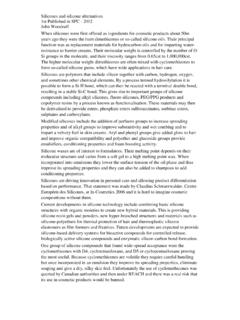Transcription of Silicones as Alternatives to Hydrocarbons in Personal Care ...
1 Silicones as Alternatives to Hydrocarbonsin Personal care FormulationsAlfred J. DiSapioDow Corning as Alternatives to Hydrocarbons in Personal care FormulationsSilicones as Alternatives to Hydrocarbonsin Personal care FormulationsAlfred J. DiSapioDow Corning use of Silicones in Personal care products has been expanding rapidly. Asignificant portion of this increased use has been in place of Hydrocarbons . For atleast 15 years, Silicones have been incorporated into Personal care products as apartial replacement or improvement additive for several classes of organic com-pounds traditionally used as ingredients in cosmetics and toiletries. This move-ment from Hydrocarbons to Silicones has been ongoing, driven by several marketforces, and at an increasing of the Hydrocarbons affected were from categories of fatty chemicals, in-cluding the esters, acids, and alcohols. Cost differential has been narrowing asthe volume of silicone used increases and the demand for greater purity has addedcost to some organics.
2 When the added value of sensory and functional benefits isconsidered, the balance of total value is frequently in favor of flexible functional and sensory capabilities of Silicones make them an in-teresting candidate for the reduction of organic materials in cosmetic and toiletryformulations. This presentation provides a useful comparison between siliconesand several of the hydrocarbon classes of materials from sensory, functional, andenvironmental perspectives. In addition, formulation examples from various per-sonal care product segments illustrate how Silicones can help meet increasinglystringent marketplace the past 15 years, Silicones have been evaluatedand used as substitutes or enhancements for severalclasses of organic materials. Various organic ingredi-ents such as esters, alcohols, and fatty compounds havebeen affected by silicone technology. Some replacementhas occurred in the following product segments:SegmentMaterial Replaced by SiliconesAntiperspirant EsterDeodorantEthanolSunscreenMineral oilColor cosmetics Ethanol, mineral spirits FragranceEthanolSkin careMineral oil, esters, fatty compoundsRecently, the group of materials described by theCosmetic, Toiletry and Fragrance Association (CTFA)as Hydrocarbons has been the focus of more active re-placement efforts.
3 The CTFA describes these materialsas a group of compounds containing only carbon andhydrogen, mostly derived from petroleum. As a rule,they are chemically inert and may contain aliphatic,alicyclic, and aromatic Pressure to replacehydrocarbons in Personal care products is growing as aresult of several factors, including:lA demand for improved functional performance,such as moisturizationlInterest in the enhanced therapeutic value offeredby protective and non-comedogenic productslRegulatory issues, such as volatile organic com-pound (VOC) restrictionslA shift in sensory preferences on the part ofconsumerslConsumer attitudes, including concern over petro-leum derivativeslAvailability and understanding of alternativematerials-1-Alfred J. DiSapioThe Emergence of Oil-Free ProductsMineral oil, a petroleum distillate, is a ubiquitous cos-metic and toiletry ingredient from the hydrocarbonclass.
4 It is widely used as an emollient and unctuousvehicle. The CTFA describes mineral oil as a mixtureof saturated Hydrocarbons , which is highly refined tominimize aromatics, metals, and other impurities. Thematerial is further described as having a molecularweight range between 220 and 530 and a viscosity rangebetween 3 and 100 cSt at 40 The lower molecularweight distillates have the CTFA nomenclature of min-eral spirits and have been used as solvents in a varietyof makeup oil was previously on the periphery of thetrend toward replacement of organic materials. It iswidely used, and an extensive knowledge base has beendeveloped with respect to formulating it into oil-in-wa-ter emulsions, the most common skin care product , two recent market developments have focusedinterest on the replacement of mineral oil: changes insensory needs and consumer environmental , sensory perceptions of oiliness and greasinesshave become increasingly significant consumer-per-ceived parameters.
5 Consumers have been conditionedto appreciate light, dry, silky-feeling products with mini-mal perceptible residue. This preference change has re-sulted in the emergence of an oil-free product examination of the products in the foundation andcleanser categories launched in the in 1990 and1991 not only reveals expanding silicone use, but sug-gests that Silicones are being used in oil-free productsto perform some of the functions typically attributed tomineral oil, such as emolliency. Table I summarizesthese product summary of foundation and cleanserproducts introduced in 1990 and advertisedas oil-freeas oil-freeNo. containing mineral oil2 (10%)44 (51%)No. containing silicone11(58%)26(30%)Total no. of products1986As might be expected, 51% of the products not adver-tised as oil-free contain mineral oil. Surprisingly, a smallnumber (10%) of those advertised as oil-free still con-tain some mineral oil.
6 It is also clear from these datathat the percentage of products using Silicones in oil-free categories has almost doubled from 30% in the non-oil-free category to 58% in those advertised as for this change and the reasons be-hind it came from a consumer focus group study con-ducted in Germany, France, and the United Kingdom,which shed additional perspective on the concept of In all three countries, the concept of oil-free/non-greasy was positive for most skin care products, with astrong preference for the non-greasy terminology. Thedesire for non-greasy products appeared to reflect con-sumer interests in benefits such as:lAn ability to absorb or rub in quicklylNo residue or pore clogging effectlA non-sticky feel No skin shineEnvironmental TrendsThe second marketplace force is the ongoing consumerconcern about the environment. The impact of this is-sue on mineral oil use in cosmetics and toiletries is ana-lyzed in a recent trade The author reports thatconsumer-driven environmental interests started witha movement toward the elimination of pesticides, movedon to the elimination of animal-derived ingredients, thento the Green movement, on to natural products, andfinally to environmentally safe products.
7 He furtherstates that one of the major issues confronting theseenvironmentally concerned manufacturers is the elimi-nation of petrochemical and continues, The systematic review of formulations to eliminatepetrochemical derivatives has focused on mineral One of the author s conclusions is: Based on this infor-mation, it would seem that Silicones may offer somepossibilities as replacements for mineral oil. Recent studies summarize the environmental safetyprofiles of dimethicone and cyclomethicone, the twomost commonly used families of silicone in Personal In addition, on the consumer side, it is inter-esting to note that some major consumer publicationsposition Silicones toward the natural category. De-scriptions of this type are significant, because until thereare acceptable industry standards for the terms natu-ral or naturally derived, consumer beliefs are a de-terminant factor.
8 For example, in one instance, siliconesare described as a derivation of natural minerals. 5 Inanother example, silicone is described in the followingmanner: ..it s natural most of it comes from the sandyou lie on when you re on the beach .. 6It is also important to note that the CTFA dictionarydoes not classify Silicones as oils. Instead, Silicones aretypically classified as specialty Similarly,chemical references define mineral oils as a mixture ofliquid Hydrocarbons derived from petroleum,7 a defini-tion that excludes polydimethylsiloxane (PDMS).Functional and Sensory CharacteristicsIn comparing mineral oil and silicone for cosmetics andtoiletries, the subjects of emolliency, occlusivity,comedogenicity, and sensory characteristics must is generally agreed that the primary function of min--2- Silicones as Alternatives to Hydrocarbons in Personal care Formulationseral oil in a formulation is emolliency, which can beviewed as having two components, spreadability andlubricity.
9 These parameters have been quantified andreported for dimethicone and various on panel evaluations, the authors report thatdimethicone, 350 cSt, has the highest spreadability andis rated as more spreadable by a factor of ten comparedto mineral oil, 150 on lubricity measurements obtained with askin friction device, dimethicone has a friction factorthree times lower than that of mineral oil. From for-mulas derived in the paper for calculating emolliency,8dimethicone shows significantly greater emolliency thanmineral oil: by a factor of eight when measured duringthe application period, and by a factor of five whenmeasured as residual , low molecular weight polymers ofdimethicone and cyclomethicone are uniquely classifiedas the most astringent emollients of all thirty hydro-carbons tested. As molecular weight is increased, theybecome substantial protective emollients.
10 They are theonly materials to exhibit this bifunctional oil has sometimes been characterized as pro-viding some occlusivity, which is related to skinmoisturization. But this assertion is not supported bydata from transepidermal water loss measurements,which provide a fairly direct indication of occlusivity. Arecent study shows that the major ingredient affect-ing occlusivity of the O/W emulsion systems is petrola-tum, not mineral oi1. 9 Most silicone fluids arerecognized as non-occlusive. Some organically modifiedsilicone products such as stearoxytrimethylsilane andstearyl alcohol do provide considerably greaterocclusivity than mineral oil although significantly lessthan initial study showed Silicones of all classes tested tobe A more extensive study con-firmed the earlier work, reporting that Silicones showed no significant increase in follicular keratosis, the mostinnocuous The same study also indicated thatmineral oil was more erratic with respect tocomedogenicity, with scores ranging from no effect tomild comedogenicity.









